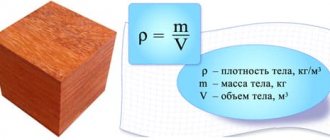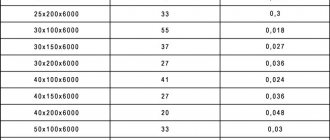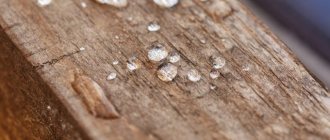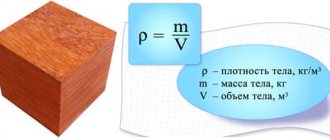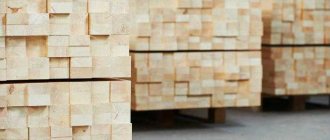The effect of humidity on the weight of wood
The weight of wood does not always have the same value. What does it depend on? First of all, from the moisture content of the wood. If we compare, for example, oak and birch, it turns out that a cubic meter of oak weighs 700 kg, and a birch weighs 600 kg. But it could be different. Weighing a cubic meter of birch, we get 900 kg, and oak will show the same 700. Or in both cases it will be 700 kg. Why do we get such different numbers? In this case, the moisture content of the wood plays a role.
There are four degrees of humidity: dry (10-18%), air-dry (19-23%), damp (24-45%) and wet (above 45%). Thus, it turns out that different rocks with the same humidity have different weights, as in the first example above. If the humidity is not the same, then the weight may fluctuate in one direction or another. The standard humidity is 12%.
Lumber Tables
Below are detailed data that will immediately allow you to determine the required amount of lumber from 3 to 6 meters in length. It is very easy to use these tables - we find the required product sizes and see the amount of material and the volume of one element.
Helpful information.
Please note that these tables are approximate results. Doing your own calculations is more accurate. In addition, different manufacturers approach the stacking of lumber in their own way, so the density of the products can vary greatly. Therefore, make a reserve of about 10-20%, otherwise you will have to pay for delivery again.
Table 1.
The number of boards in 1 cubic meter of materials.
Table 2.
The amount of timber in 1 cubic meter of materials.
Table 3.
The amount of lining in 1 cubic meter of materials.
Heat transfer from wood
In addition, there is another indicator - heat transfer. It will come to the aid of those who use wood as firewood for heating. The higher the hardness, i.e. The density of the wood species, the higher its calorific value. Of course, no one will heat a room with boxwood, but when choosing between linden and pine or birch and acacia, you can get much more heat if you know which of these species is the hardest. Information about the density of each tree can be gleaned from the tables, since all this information is systematized for ease of use.
Weight of a dense cubic meter, kg
| Breed | Humidity, % | |||||||||||
| 10 | 15 | 20 | 25 | 30 | 40 | 50 | 60 | 70 | 80 | 90 | 100 | |
| Beech | 670 | 680 | 690 | 710 | 720 | 780 | 830 | 890 | 950 | 1000 | 1060 | 1110 |
| Spruce | 440 | 450 | 460 | 470 | 490 | 520 | 560 | 600 | 640 | 670 | 710 | 750 |
| Larch | 660 | 670 | 690 | 700 | 710 | 770 | 820 | 880 | 930 | 990 | 1040 | 1100 |
| Aspen | 490 | 500 | 510 | 530 | 540 | 580 | 620 | 660 | 710 | 750 | 790 | 830 |
| Birch: | ||||||||||||
| - fluffy | 630 | 640 | 650 | 670 | 680 | 730 | 790 | 840 | 890 | 940 | 1000 | 1050 |
| - ribbed | 680 | 690 | 700 | 720 | 730 | 790 | 850 | 900 | 960 | 1020 | 1070 | 1130 |
| - Daurian | 720 | 730 | 740 | 760 | 780 | 840 | 900 | 960 | 1020 | 1080 | 1140 | 1190 |
| - iron | 960 | 980 | 1000 | 1020 | 1040 | 1120 | 1200 | 1280 | — | — | — | — |
| Oak: | ||||||||||||
| - petiolate | 680 | 700 | 720 | 740 | 760 | 820 | 870 | 930 | 990 | 1050 | 1110 | 1160 |
| - eastern | 690 | 710 | 730 | 750 | 770 | 830 | 880 | 940 | 1000 | 1060 | 1120 | 1180 |
| — Georgian | 770 | 790 | 810 | 830 | 850 | 920 | 980 | 1050 | 1120 | 1180 | 1250 | 1310 |
| - Araksinian | 790 | 810 | 830 | 850 | 870 | 940 | 1010 | 1080 | 1150 | 1210 | 1280 | 1350 |
| Pine: | ||||||||||||
| - cedar | 430 | 440 | 450 | 460 | 480 | 410 | 550 | 580 | 620 | 660 | 700 | 730 |
| - Siberian | 430 | 440 | 450 | 460 | 480 | 410 | 550 | 580 | 620 | 660 | 700 | 730 |
| - ordinary | 500 | 510 | 520 | 540 | 550 | 590 | 640 | 680 | 720 | 760 | 810 | 850 |
| Fir: | ||||||||||||
| - Siberian | 370 | 380 | 390 | 400 | 410 | 440 | 470 | 510 | 540 | 570 | 600 | 630 |
| - white-haired | 390 | 400 | 410 | 420 | 430 | 470 | 500 | 530 | 570 | 600 | 630 | 660 |
| - whole leaf | 390 | 400 | 410 | 420 | 430 | 470 | 500 | 530 | 570 | 600 | 630 | 660 |
| - white | 420 | 430 | 440 | 450 | 460 | 500 | 540 | 570 | 610 | 640 | 680 | 710 |
| - Caucasian | 430 | 440 | 450 | 460 | 480 | 510 | 550 | 580 | 620 | 660 | 700 | 730 |
| Ash: | ||||||||||||
| - Manchurian | 640 | 660 | 680 | 690 | 710 | 770 | 820 | 880 | 930 | 990 | 1040 | 1100 |
| - ordinary | 670 | 690 | 710 | 730 | 740 | 800 | 860 | 920 | 980 | 1030 | 1090 | 1150 |
| - acute-fruited | 790 | 810 | 830 | 850 | 870 | 940 | 1010 | 1080 | 1150 | 1210 | 1280 | 1350 |
The table shows average mass values. Possible maximum and minimum mass values are 1.3 and 0.7, respectively, from its average value
What is the forest density?
Different tree species have approximately the same composition, so in dry form the absolute specific gravity for all will be roughly the same. Its average value is 1.54 (dimensionless value). But the wood density table shows its own numbers for different species. The fact is that in a completely dry state it is almost impossible to measure the absolute parameter. To do this, it is necessary to completely get rid of moisture in the test sample and eliminate air voids. In practice, as it turned out, it is difficult to fix the parameter, and it is not suitable for calculations.
To determine the density of lumber, calculating its specific gravity is more suitable
.
It is influenced by:
- humidity;
- rock porosity.
The specific gravity of wood has the form of the average value of density calculations in its different states. This figure may vary slightly in sources. The difference is due to changes in the moisture level inside the trunk. To avoid confusion, we present a table with average specific gravity values at each individual moisture level for different wood species in ascending order.
Table of wood densities of different humidity levels (kg/m3)
Tree species groups
Typically, the table value of the density of timber and other lumber is measured at a humidity of 12%. Depending on the obtained value, tree species are divided into 3 groups:
- With low volumetric mass (less than 540 kg/m3). These include coniferous trees: pine, spruce, fir, cedar and some deciduous trees. These are all types of alder, poplar, linden, aspen, chestnut.
- With an average specific gravity of 550–740 kg/m3: beech, elm (elm), larch, all types of maple, rowan, apple, ash.
- With a high level of density over 750 kg/m3: birch, oak (Araksin, chestnut-leaved), hornbeam, dogwood, pistachio.
Of course, this is an incomplete list of breeds. Based on the wood density values indicated in the table, you can determine whether the species belongs to the group.
Humidity dependent
All lumber contains water. Its quantity mainly determines the density of timber and other raw materials: the more moisture in the product, the higher the weight in the measured volume.
The specific gravity of wood in the table is given in average values, since the amount of moisture in one volume is constantly changing - this is a relative value.
Changes occur due to:
- external weather conditions (rain, fog, snow);
- anthropogenic factor (wetting due to human activity).
Thus, a completely dry board practically never happens. Wood moisture content is always above 0%
. This indicator can be determined using a special device - a moisture meter.
Impact on wood quality
The average specific gravity is the main characteristic of raw materials when carrying out calculations, since the value contains an average assessment of tests of lumber in different states of water saturation.
According to the laws of physics, the calculated density is directly related to the strength of the material: the higher the specific gravity of the volume of the product, the greater the load it can withstand. This rule also applies to wood.
Let's look at an example:
- Oak has a high specific gravity and is famous for its reliability and durability. It has almost no empty pores, the entire volume is filled with strong wood fibers and moisture. Load-bearing structures of houses and industrial facilities are made from oak. Wood with a high specific gravity is rigid and practically does not bend.
- Cedar and birch beams have a low volumetric weight, which is why they are not used to create load-bearing elements of the frame of structures. These rocks are more suitable for finishing work, where the load on the product is minimal. Wood with low porosity is plastic and bendable.
Relationship between density and thermal conductivity
This indicator is important for choosing a tree when preparing firewood. The relationship is direct: the higher the density index, the more fuel there is in the lumps, the longer they will burn. Wood species with a high mass-to-volume ratio are called solid fuels. They burn for a long time, give good heat, but due to their dense structure they are difficult to prick. The advantage of firewood and fuel from light tree species is their flexibility in sawing and cutting, but they have a relatively small energy reserve. The logs will burn for a significantly shorter amount of time.
When organizing timber transportation, the density of the tree is an important indicator when selecting a timber truck and calculating the cost of transportation. This will help avoid overloading, which will consequently prevent you from being fined.
The density of the material has a special significance on the weight of m3 of wood; accordingly, to correctly solve the questions posed, it is necessary to determine the value of the density. There are two types of density: volumetric weight
(density of the structured physical body) and
specific gravity
(density of the wood substance).
Table of density of wood chips and sawdust depending on the type of wood
This User Agreement is a public document of the administrator of the site https://stanki35.ru (hereinafter referred to as the Administrator) and determines the procedure for the use by visitors (hereinafter referred to as the Visitor) of the site https://stanki35.ru owned by the Administrator, and the processing, storage and other use of information, received by the Administrator from the Visitor on the Administrator’s website. The site administrator may change this User Agreement at any time without notifying the site visitor.
- A site visitor, leaving any information relating directly or indirectly to a specific or identifiable individual (hereinafter referred to as Personal Data), confirms that he has read this User Agreement and agrees with it.
- With regard to all reported Personal Data, the Visitor gives the Administrator full consent to their processing.
- The site administrator guarantees to the Visitor that the processing and storage of the Visitor’s personal data received will be carried out in accordance with the provisions of the Federal Law of June 27, 2006 No. 152-FZ “On Personal Data”.
- The site visitor understands and agrees that providing the Administrator with any information that has nothing to do with the purposes of the site is prohibited. Such information may be information relating to the state of health, intimate life, nationality, religion, political, philosophical and other beliefs of the Visitor, as well as information that is a commercial, banking and other secret of the Site Visitor.
- The Administrator guarantees to the Visitor that it uses the Personal Data received from the Visitor solely for purposes limited to the marketing, advertising, information purposes of the Administrator, as well as for analysis and research of Site Visitors, as well as for the purpose of providing him with goods and services directly located or not, on the Administrator's website.
- The visitor in accordance with Part 1 of Art. 18 of the Federal Law “On Advertising” gives the Administrator his consent to receive advertising messages via the specified contact information.
- The visitor is solely responsible for violating the law when using the Administrator’s website.
- The Administrator does not bear any responsibility in the event of a violation of the law by the Visitor, and does not guarantee that the content of the site corresponds to the goals of the Site Visitor.
- The site visitor is solely responsible if the rights and legitimate interests of third parties are violated when using the Administrator’s site by the Visitor.
- The Administrator has the right to prohibit the Visitor from using the site if there are legal grounds for doing so.
Calculation features
Let's consider the features of the calculation for the most popular types of materials. To calculate the weight of lumber of rectangular or square cross-section (edged, profiled, planed boards, timber), the formula is used: volume * density, where volume is calculated by the formula length * width * height. In this way, the weight of one board is calculated, then multiplied by the number of boards per cubic meter. For example, let’s calculate how much a freshly sawn pine board 50x150x6000 mm will weigh at a humidity of 40% (we take the density of pine at a given humidity from a reference book - 590 kg/m3).
- (6 m * 0.05 m * 0.15 m) *590 kg/m3 = 26.6 kg – the weight of one board.
- 26.6 x 22 = 585.2 kg – weight per cubic meter.
For comparison at 20% humidity:
- (6 m * 0.05 m * 0.15 m) *520 kg/m3 = 23.4 kg – the weight of one board;
- 23.4 x 22 = 514.8 kg – weight per cubic meter.
Using this algorithm, it is easy to calculate the weight of a cubic meter of board or timber of the required dimensions - 50x200x6000 mm, 40x150x6000 mm, 50x100x6000 mm, 150x50x6000 mm, 50x50x6000 mm and others.
Unedged boards cannot be stacked as tightly as rectangular boards, and the materials in a batch may vary in size. In order to calculate the weight of a cube of these materials, you need:
- selectively measure the dimensions of materials in a batch;
- calculate the arithmetic average volume of a log or board;
- calculate the weight of one board;
- multiply the average weight by the number of boards in the batch.
If the batch is too large and it is not possible to count the number of boards or logs, use the batch method for determining weight - determine the volume of the package in which the lumber is placed, then use reduction factors to calculate the weight (specified in OST 13-24-86).
To calculate the weight of a cube of firewood, the batch method is also used, but it must be taken into account that the rules for laying them are strictly standardized. If the firewood is stacked in bulk, when making calculations you need to:
- convert the volume of a bulk cube into a folded one;
- calculate the weight using the reduction factor from GOST 3243-88.
For example, to convert a volume of chopped hardwood firewood 25 cm long into a folding cube, a coefficient of 0.7 is usually used. If, for example, they are poured into a standard ZIL-130 body with low sides, then to find out the volume, you need to multiply the body volume of 5.98 m3 by this coefficient. The resulting value of 4.1 m3 is the volume of firewood neatly stacked in the woodpile. The weight of such birch firewood at 40% humidity is 2274.6 kg (4.1 m3 x 730 kg/m3 x 0.76), where 0.76 is the correction factor), and the weight per cubic meter is 554.8 kg.
For round lumber, the calculation rules are defined by GOST 2292-88 and GOST 2708-75.
- To calculate the volume of one rounded log, the GOST 2708-75 cubeturner is used.
- For untreated logs, the dimensions of a certain number from the batch are selectively measured, determining the diameter along the upper (thin) edge without taking into account the bark. Based on the average, further calculations are made.
To calculate the weight of bulk materials (sawdust, shavings), correction factors from the corresponding reference tables are used.
